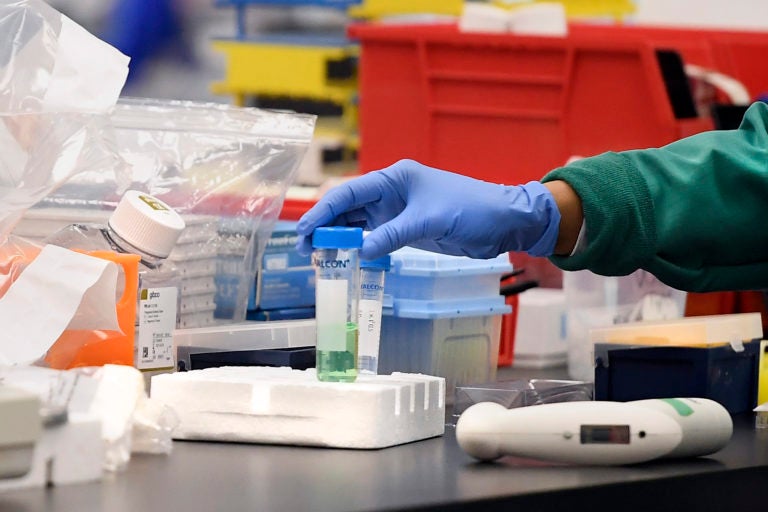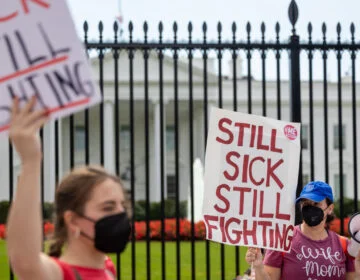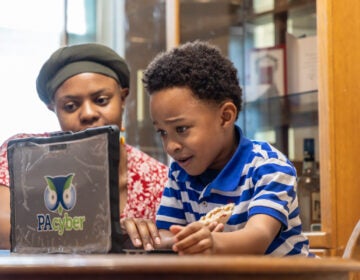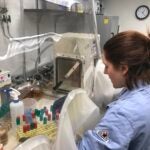One recipe for a coronavirus vaccine: add rabies
A Jefferson lab has built on its rabies vaccine research to create one for COVID-19. But a final product could be a year away.

A researcher moves a vial in a lab. Labs are ramping up their research, in the hopes of finding a vaccine for COVID-19. (Jessica Hill/AP Photo)
This story is from The Pulse, a weekly health and science podcast.
Subscribe on Apple Podcasts, Stitcher or wherever you get your podcasts.
Think for a minute about 2-in-1 shampoo. It’s a pretty simple idea, cleaning and conditioning your hair at the same time, though you might debate how well some products work.
Turns out the 2-in-1 concept can actually work for vaccines, even one for COVID-19. Here, the 2-in-1 is part-rabies vaccine with a bit of SARS-CoV-2 protein tagging along. (SARS-CoV-2 is the official name for the new coronavirus. COVID-19 is the disease it causes.)
The work is being done by the lab of Matthias Schnell, chair of microbiology and immunology at Thomas Jefferson University. The Schnell lab develops vaccines for emergent diseases. The team’s members have tackled Ebola, SARS, and MERS in the past, and now they’ve developed a vaccine for COVID-19 — actually, three of them.
Using the rabies vaccine is part of their success and makes the project more viable. The rabies vaccine is well established, without unpleasant neurotoxic effects. Most importantly, It can be commercially produced to scale. One company Schnell cited as an example can produce 10 million doses a year.
Schnell has done extensive work on rabies vaccines. “We saw a lot of emergent infectious diseases were actually in areas where rabies is a big problem,” he said. So why not use the work they’d already done and apply it to other viruses?
The goal of a vaccine is to give your immune system the chance to learn what a virus looks like and prepare a response to it, even before you’re infected. To do that, vaccine developers can use either harmless fragments of a virus or an inert, chemically inactivated virus. The rabies vaccine uses an inert virus.
To make a COVID-19 vaccine, Schell’s lab picked a piece of the Sars-CoV-2 virus, a little bit of protein, and added it to the inactivated rabies virus. Theoretically, the vaccine would make the person receiving it immune to both rabies and Sars-CoV-2. If you came in contact with either virus after getting the vaccine, your body would already have prepared its immune system by making antibodies.
“Most people, as a target, use one specific protein of the virus, which the virus uses to enter cells,” he said. “So if you develop antibodies against this receptor from the virus, it would not be able to infect you, and that would be the goal.”
However, Schnell says there are many ways to make a vaccine. “I guarantee you there are probably 500 people working on that vaccine right now, or 500 groups,” he said. And although he predicted some overlap, there will also be many novel approaches, he said.
Five hundred groups means there’ll be competition as many labs rush to get vaccines out. But competition is good, he said.
Schnell estimates there might be as many as 20 different candidate vaccines. But don’t expect this wide-range of options to translate to the doctor’s office. As testing continues, some vaccines will be weeded out.
“You can’t lie about viruses and vaccines. You test them, they work or they don’t,” Schnell said.
Schell went on to explain that sometimes logistics plays a huge role, the best vaccine is sometimes the one that is easiest to store and transport.
Because no matter how promising a vaccine looks at the start, it’s a long way from the lab to patients. Once the initial vaccine has been developed and tested in animals, the researchers need to partner with a company. Then that vaccine goes to three rounds of clinical trials. If it passes all three rounds, it can go to market. Schnell thinks a responsible estimate is a year, from start to finish.
“I think it’s wrong to tell people things like, ‘I can make a vaccine in three months,’ because it’s not really true, and I think we have to be careful not giving false security to people,” he said.
Although the lab worked on other coronaviruses, Schnell’s group pulled this vaccine together in less than two months. That was possible for a couple of reasons. Collaboration is a big one. A successful vaccine represents the work of virologists, immunologists, structural biologists, and hundreds of staff hours.
“I didn’t do anything,” Schnell said. “I have a very good research team. They did all the work, they were up day and night.”
Even though a vaccine won’t be ready soon, Schnell has some good news: If COVID-19 is a human-only virus, like the measles, eradication is a possibility. Once enough people have antibodies, there will be nowhere for the virus to go.
WHYY is your source for fact-based, in-depth journalism and information. As a nonprofit organization, we rely on financial support from readers like you. Please give today.




![CoronavirusPandemic_1024x512[1]](https://whyy.org/wp-content/uploads/2020/03/CoronavirusPandemic_1024x5121-300x150.jpg)



